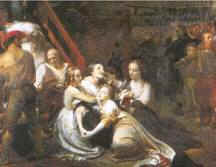|
The government couldn't let
these revolts
destroy everything that they had worked so hard for, and so the
Convention set up a group of 12 government officials who had the power to
do absolutely anything they liked to save France against another collapse
and more revolts and rebellions. The group was called the "Committee
of Public Safety." The year after the group was established, all
opponents of the government were severely dealt with. The punishments were
so cruel and harsh that this time became known as the "Reign of
Terror".
In 1793, a "Law
of Suspects" had to be issued from every town. The citizens of
each town were made to list people who they suspected opposed the
government. Practically anyone and everyone could be suspected, becoming
people who "by their behaviour, their contacts, their words or their
writings, showed themselves to be...enemies of Liberty." Over 250,000
suspects were put in prison in the next 12 months. In Paris, the
Revolutionary Tribunal tried many suspects. Its judges could condemn
people to death. Around half of their sentences were death sentences. The
people were executed using a newly invented machine called a
guillotine.
|
|
| |
|
|
| |
 |
|
| |
Sisters and
their mother waiting to be guillotined because they were relations
of a rebel leader. |
|
Among
the 17 000 or so people executed during the Terror, Marie Antoinette was one of
the first. She was executed in
October 1793, found guilty for treason. The guillotine was sometimes proved too
slow to execute enough people. In the Vendée, huge revolts were taking
place. Over 100 representatives of the Convention were sent there to settle the
problems. But there were too many found guilty, and the guillotine was too slow
to keep up. At least 2 000 people were drowned, another 2 000 were lined up in
front of open graves and placed brutally into them with cannon fire. In
August 1793, the Convention ordered every citizen out to war. Unmarried
men were sent to fight. Married men had to make weapons. Women made tents and
served in hospitals, and their children made gunpowder and bandages. Soon, the French
armies amounted to 800 000 men. This was 3 times the size of the Coalition's
armies. Strict discipline was kept, and any Generals who lost battles were
replaced with younger and more able leaders. The
rising food prices were becoming a dire problem. In September 1793, the "Law
of the Maximum" was imposed to try to halt the increasing prices by
fixing a price that should not change until further notice. Breaking this law
carried a death penalty. The Terror
destroyed religion is some parts of France. The Sans-Culottes claimed that
religion was nothing but superstition, and closed down churches, sacked the
priests, and stole the bells and the silver. The revolutionary ideas of freedom
replaced those of Christianity. The Convention issued a new calendar where years
were no longer counted from Jesus' birth, but from the forming of the Republic
of France. Sunday was abolished, the months took on names that described their
weather, and months had 10 day weeks.
The Committee of Public Safety was successful.
France did not collapse. It had avoided a famine, was winning the war, and has
crushed the revolts in the provinces. But this success came with a heavy price.
About 37 000 people had been executed or had died in revolting, dirty
prisons. Everybody's rights had been limited, and the Committee had become a
sort of 12 man dictatorship.
The Coup of
Thermidor
By the end of 1794, the Committee was
becoming increasingly unpopular. People disliked it because they thought it was
too powerful, they were scared they would be executed, other people said that
there was no need for it anymore because France was winning the war and the
revolts had finished. The Sans-Culottes, originally its' most enthusiastic
supporters, were now unhappy because of rising food prices. Despite the
"Maximum" law, prices were still rising, while wages were being held
down. The 9th of Thermidor, Year 2 (27th July 1794 on the new calendar), the
Convention decided to dispose of Robespierre-the Committee's leading member, and
his supporters. Over the next 2 days, 117 people were arrested and
guillotined. Robespierre was now dead. The Convention decreased the power of the
Committee. Hundreds of suspects were freed, the Maximum was eradicated, as was
the Revolutionary Tribunal.
The Terror came to an
end.
 Back
to Main Events Back
to Main Events

|